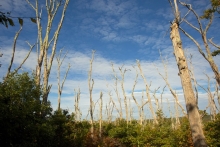Woolly Bully and the Hemlock Trees Project Ecologist David Orwig has been all over the news recently.
David Orwig and Gary Lovett, a scientist from the Cary Institute contributed to new paper dealing with invasive pests and pathogens that was released by the Science & Policy Exchange recently. This paper has been getting tremendous media attention.
The following update was put together by Clarisse Hart :
Tuesday, May 10, 2016

Imported forest pests cause more than $2 billion in damage each year and can be found in all 50 U.S. states. Efforts to prevent new pests must be strengthened if we are to slow the loss of our nation’s trees, says a new study co-authored by Harvard Forest scientists David Orwig and David Foster. The study was led by the Cary Institute of Ecosystem Studies and coordinated by the Science Policy Exchange, a research consortium based at the Harvard Forest and led by Kathy Fallon Lambert and Marissa Weiss.
The study, published today in Ecological Applications, was conducted by a team of 16 scientists - from Harvard Forest, the USDA Forest Service, The Nature Conservancy, Dartmouth College, McGill University, and Michigan State University. It is the most comprehensive synthesis to date on forest pests. It covers both ecological and economic impacts and evaluates a range of policy solutions.
According to the study, 57 imported forest pests live in Massachusetts today. Our region is particularly susceptible to new pests because our forests contain many trees that are closely related to trees in Europe and Asia.
Today, sixty-three percent of U.S. forestland, or 825 million acres, are at risk of increased damage from pests that have already established here. 70% of those forest pests arrived on imported plants. An average of 2 to 3 new pests arrive each year.
Current efforts to prevent new pests are not keeping pace with escalating trade. However, the study reports that current trade policies are projected to return $11 billion in net benefits by 2050. The authors project larger benefits with stronger pest prevention efforts.
- Read stories in The Washington Post, The Boston Globe,The Atlantic's CityLab, local NPR (MA/NY, PA, CO), and Popular Science.
- Explore the full scientific paper in Ecological Applications: Non-Native Forest Insects and Pathogens in the US: Impacts and Policy Options
- Browse the press release and related video.
- Learn more about the Science Policy Exchange.
- Read more about invasive species research at Harvard Forest.
(Photo of dead oaks on Martha's Vineyard, due to invasive winter moth caterpillars, by David Foster.)
------------------------------------------------------------------------------------------------------------------------
Listen to this radio interview David Orwig at:
WAMC – Berkshire Bureau
http://wamc.org/post/new-study-calls-stepped-forest-pest-prevention#stream/0
http://wamc.org/post/new-study-calls-stepped-forest-pest-prevention#stream/0
More articles related to this story:
http://www.newsweek.com/more-forest-pests-ever-are-entering-us-and-its-costing-public-fortune-458060
WESA – Pittsburgh
http://wesa.fm/post/pa-second-only-ny-number-invasive-forest-pest-species
E&E News Greenwire
http://www.eenews.net/greenwire/2016/05/10/stories/1060036983
Twitter Highlights:
From @postgreen:
https://twitter.com/postgreen/status/730068597897363458
From @USLTER
https://twitter.com/USLTER/status/730083988438548480





“I had my forest study today at Noble View (Berkshires)…. It is sad to report that the forest is completely devastated. All the large hemlock are at 90% destroyed of needles. The change between last year and this year is tremendous. It is so sad. There are some small semi healthy ones, but I don't know if they will make it.” Lise Letellier, Holyoke Catholic High School
ReplyDelete